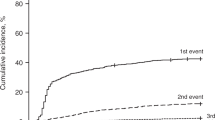Abstract
Episodes of bacteraemia during the aplastic phase were studied in 500 allogeneic bone marrow (BMT) recipients, regarding incidence, microbial aetiology, risk factors, mortality and causes of death. One hundred and sixty-four patients (33%) had at least one positive blood culture. Gram-positive cocci (α-streptococci and coagulase-negative staphylococci) were found in 146/164 cases (89%). Gram-negative bacteria were present in only seven cases. Receiving marrow from an unrelated donor was the only significant risk factor for bacteraemia in univariate regression analysis. Within 60 days after BMT, 69/500 patients died. The mortality rate was significantly higher among those with positive blood cultures during the aplastic phase, 44/164 (27%) than in those without bacteraemia, 25/336 (7%). Death directly caused by sepsis was unusual in patients with α-streptococci or CNS-bacteraemia (8/146, 5%). In contrast, three of seven patients with gram-negative bacteraemia died of the infection. However, in patients with bacteraemia, 21 of 44 deaths were attributable to invasive fungal infections (18 candida, three aspergillus; autopsy findings). Among patients with negative blood cultures during the aplastic phase, 6/25 died of invasive fungal infection (three candida, one saccaromyces and two aspergillus). This indicates that early bacteraemia is associated with death from invasive fungal infection. Therefore, efforts to shorten the neutropenic period after BMT, prevention, early detection of invasive fungal infections and adjustments of immnosuppressive regimens when marrow from an unrelated donor is used, may improve the outcome after BMT.
This is a preview of subscription content, access via your institution
Access options
Subscribe to this journal
Receive 12 print issues and online access
$259.00 per year
only $21.58 per issue
Buy this article
- Purchase on Springer Link
- Instant access to full article PDF
Prices may be subject to local taxes which are calculated during checkout
Similar content being viewed by others
Author information
Authors and Affiliations
Rights and permissions
About this article
Cite this article
Sparrelid, E., Hägglund, H., Remberger, M. et al. Bacteraemia during the aplastic phase after allogeneic bone marrow transplantation is associated with early death from invasive fungal infection. Bone Marrow Transplant 22, 795–800 (1998). https://doi.org/10.1038/sj.bmt.1701404
Received:
Accepted:
Published:
Issue Date:
DOI: https://doi.org/10.1038/sj.bmt.1701404
Keywords
This article is cited by
-
Bacteremia During Early Post-allogeneic Hematopoietic Stem Cell Transplantation Period: A Single Center Experience
Indian Journal of Hematology and Blood Transfusion (2017)
-
The relationship between oral mucositis and levels of pro-inflammatory cytokines in serum and in gingival crevicular fluid in allogeneic stem cell recipients
Supportive Care in Cancer (2015)
-
Utility of surveillance blood cultures in patients undergoing hematopoietic stem cell transplantation
Antimicrobial Resistance and Infection Control (2014)
-
Etiology, clinical features and outcomes of pre-engraftment and post-engraftment bloodstream infection in hematopoietic SCT recipients
Bone Marrow Transplantation (2014)
-
The Predictive Value for Pulmonary Infection by Area Over the Neutrophil Curve (D-index) in Patients Who Underwent Reduced Intensity Hematopoietic Stem Cell Transplantation
Pathology & Oncology Research (2014)



